Evaluating Management Accounting Tools at Barry House Hotel
VerifiedAdded on 2020/06/04
|15
|4412
|51
Report
AI Summary
This report provides a comprehensive analysis of management accounting practices relevant to the Barry House Hotel. It begins by introducing management accounting and its importance, followed by an examination of specific tools such as cost accounting, price optimization, and inventory management, highlighting their pros and cons. The report then delves into managerial reporting, detailing various types of reports including cost reports, budget/performance reports, debtors reports, and inventory reports, emphasizing their significance in decision-making. Finally, the report explores costing systems, comparing and contrasting absorption and marginal costing methods, and includes income statements calculated using both methods to illustrate their practical application. The report concludes with a summary of the findings, emphasizing the importance of management accounting for effective financial management and decision-making within the hotel context.
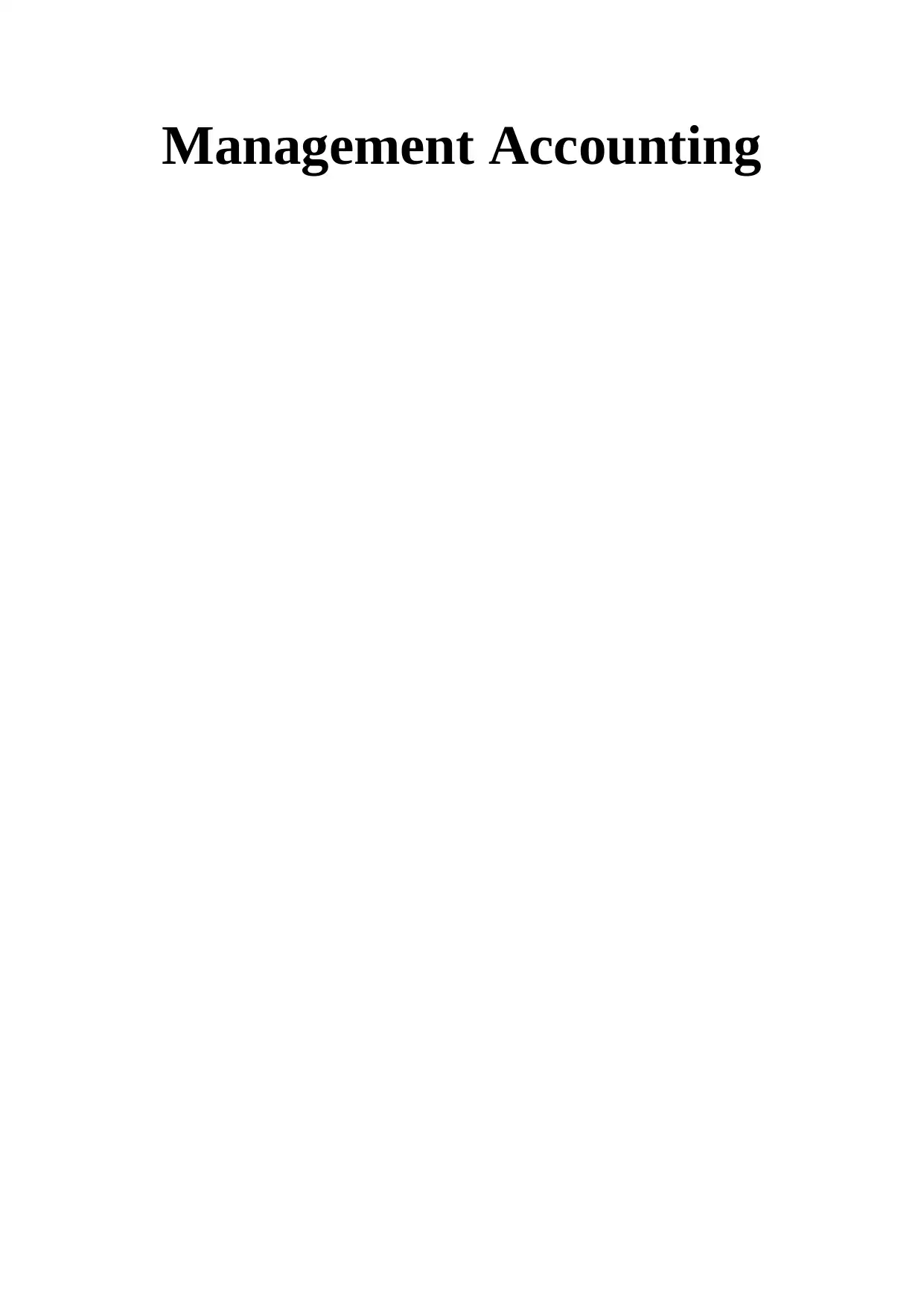
Management Accounting
Paraphrase This Document
Need a fresh take? Get an instant paraphrase of this document with our AI Paraphraser
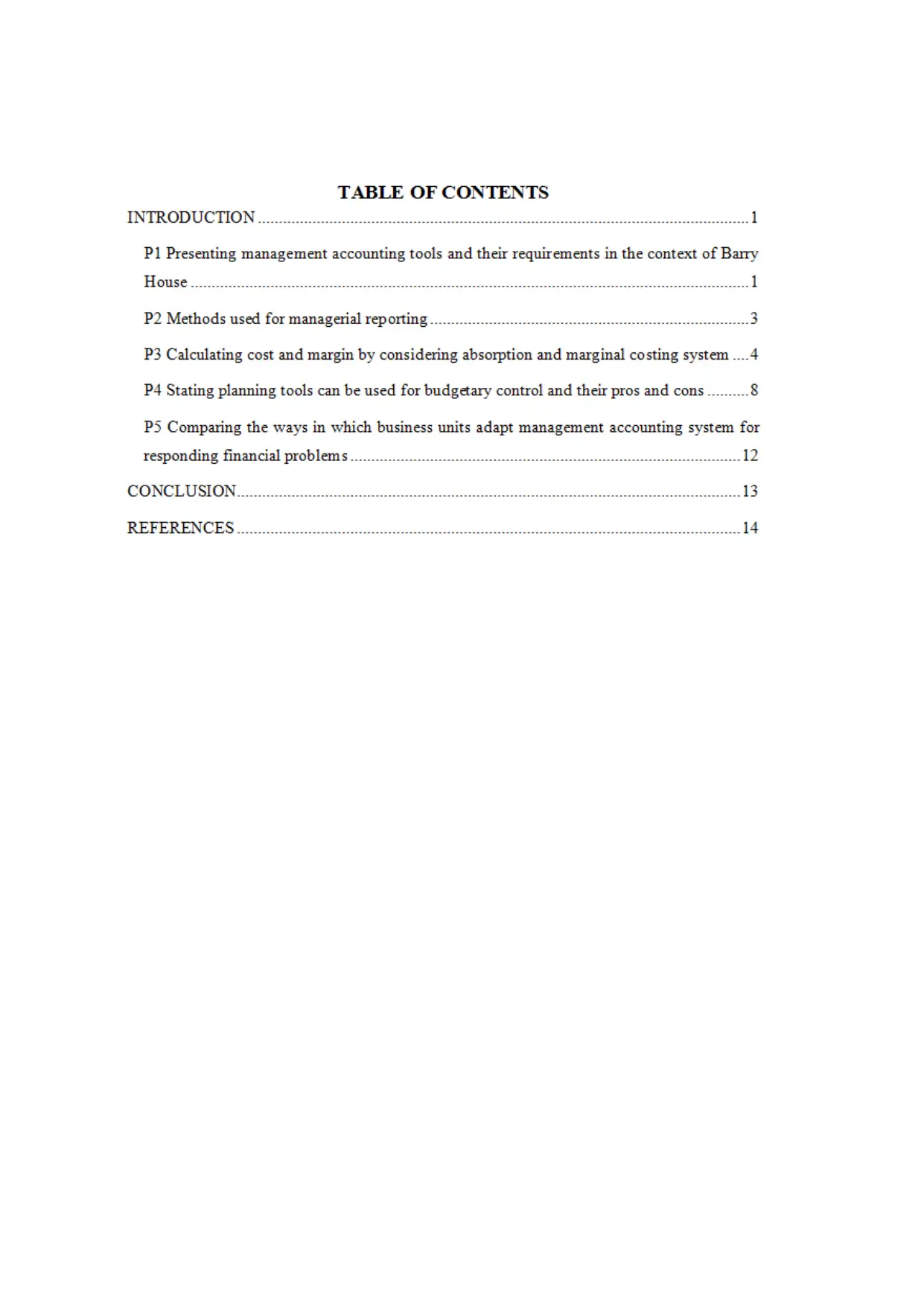
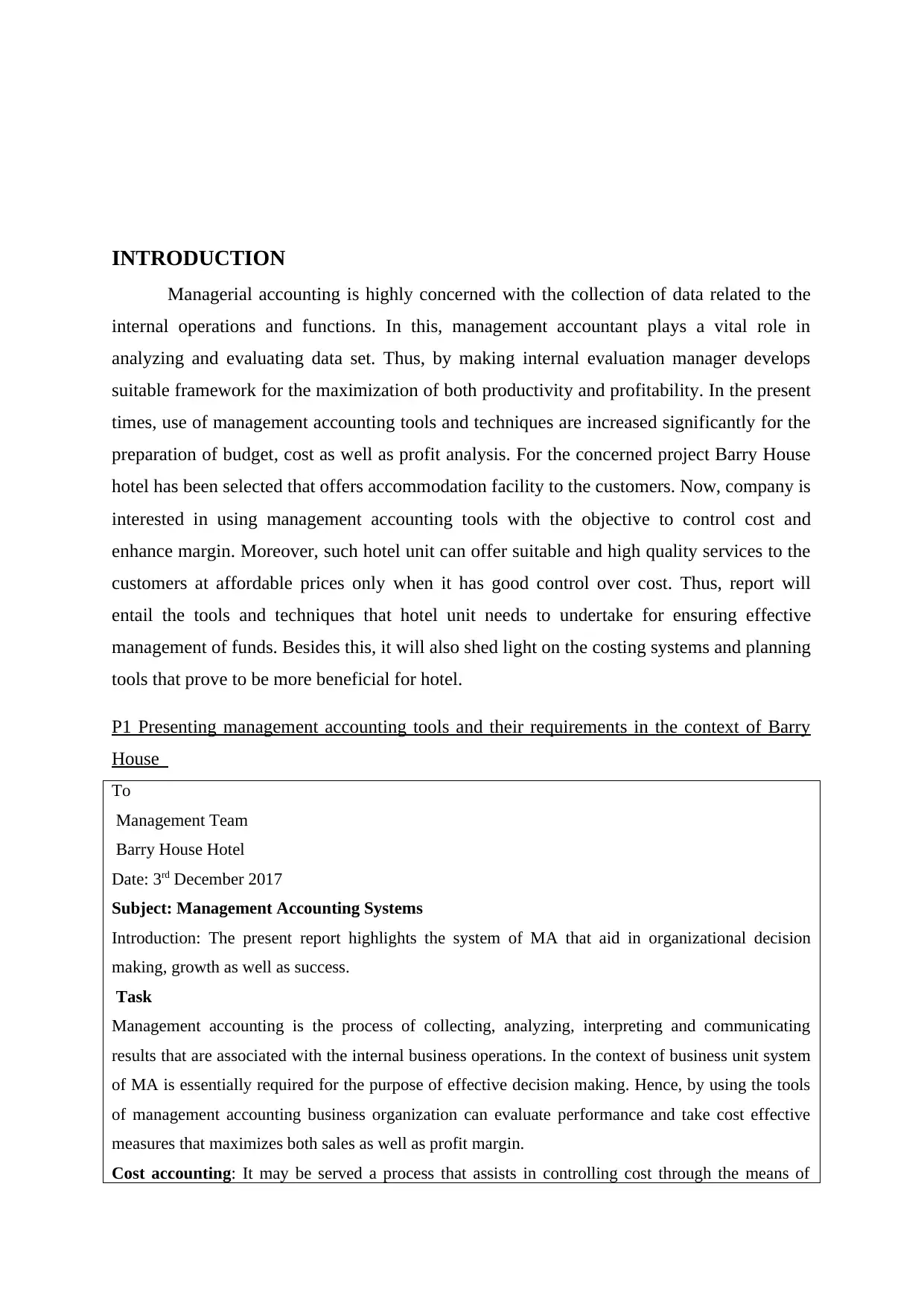
INTRODUCTION
Managerial accounting is highly concerned with the collection of data related to the
internal operations and functions. In this, management accountant plays a vital role in
analyzing and evaluating data set. Thus, by making internal evaluation manager develops
suitable framework for the maximization of both productivity and profitability. In the present
times, use of management accounting tools and techniques are increased significantly for the
preparation of budget, cost as well as profit analysis. For the concerned project Barry House
hotel has been selected that offers accommodation facility to the customers. Now, company is
interested in using management accounting tools with the objective to control cost and
enhance margin. Moreover, such hotel unit can offer suitable and high quality services to the
customers at affordable prices only when it has good control over cost. Thus, report will
entail the tools and techniques that hotel unit needs to undertake for ensuring effective
management of funds. Besides this, it will also shed light on the costing systems and planning
tools that prove to be more beneficial for hotel.
P1 Presenting management accounting tools and their requirements in the context of Barry
House
To
Management Team
Barry House Hotel
Date: 3rd December 2017
Subject: Management Accounting Systems
Introduction: The present report highlights the system of MA that aid in organizational decision
making, growth as well as success.
Task
Management accounting is the process of collecting, analyzing, interpreting and communicating
results that are associated with the internal business operations. In the context of business unit system
of MA is essentially required for the purpose of effective decision making. Hence, by using the tools
of management accounting business organization can evaluate performance and take cost effective
measures that maximizes both sales as well as profit margin.
Cost accounting: It may be served a process that assists in controlling cost through the means of
Managerial accounting is highly concerned with the collection of data related to the
internal operations and functions. In this, management accountant plays a vital role in
analyzing and evaluating data set. Thus, by making internal evaluation manager develops
suitable framework for the maximization of both productivity and profitability. In the present
times, use of management accounting tools and techniques are increased significantly for the
preparation of budget, cost as well as profit analysis. For the concerned project Barry House
hotel has been selected that offers accommodation facility to the customers. Now, company is
interested in using management accounting tools with the objective to control cost and
enhance margin. Moreover, such hotel unit can offer suitable and high quality services to the
customers at affordable prices only when it has good control over cost. Thus, report will
entail the tools and techniques that hotel unit needs to undertake for ensuring effective
management of funds. Besides this, it will also shed light on the costing systems and planning
tools that prove to be more beneficial for hotel.
P1 Presenting management accounting tools and their requirements in the context of Barry
House
To
Management Team
Barry House Hotel
Date: 3rd December 2017
Subject: Management Accounting Systems
Introduction: The present report highlights the system of MA that aid in organizational decision
making, growth as well as success.
Task
Management accounting is the process of collecting, analyzing, interpreting and communicating
results that are associated with the internal business operations. In the context of business unit system
of MA is essentially required for the purpose of effective decision making. Hence, by using the tools
of management accounting business organization can evaluate performance and take cost effective
measures that maximizes both sales as well as profit margin.
Cost accounting: It may be served a process that assists in controlling cost through the means of
⊘ This is a preview!⊘
Do you want full access?
Subscribe today to unlock all pages.

Trusted by 1+ million students worldwide
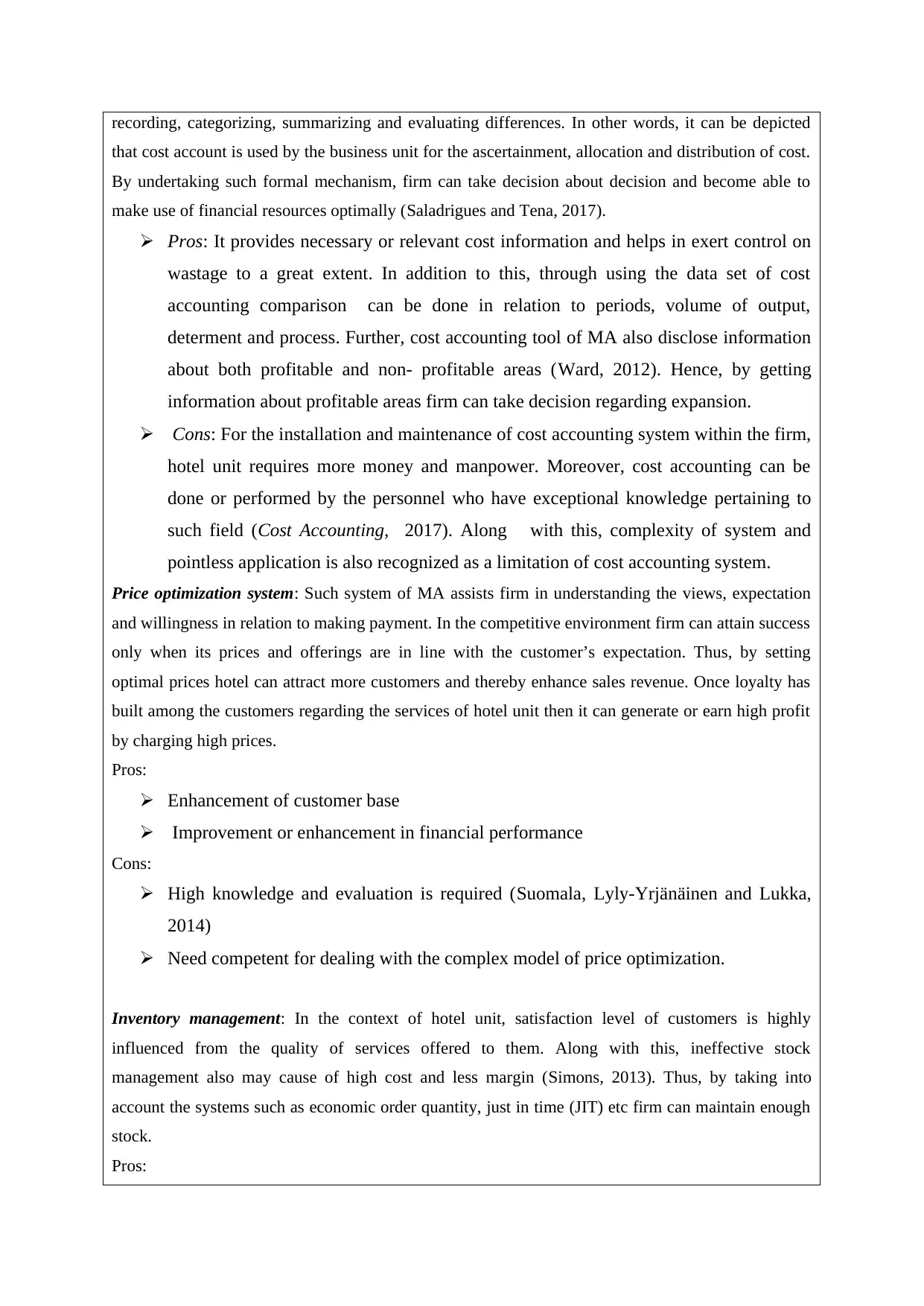
recording, categorizing, summarizing and evaluating differences. In other words, it can be depicted
that cost account is used by the business unit for the ascertainment, allocation and distribution of cost.
By undertaking such formal mechanism, firm can take decision about decision and become able to
make use of financial resources optimally (Saladrigues and Tena, 2017).
Pros: It provides necessary or relevant cost information and helps in exert control on
wastage to a great extent. In addition to this, through using the data set of cost
accounting comparison can be done in relation to periods, volume of output,
determent and process. Further, cost accounting tool of MA also disclose information
about both profitable and non- profitable areas (Ward, 2012). Hence, by getting
information about profitable areas firm can take decision regarding expansion.
Cons: For the installation and maintenance of cost accounting system within the firm,
hotel unit requires more money and manpower. Moreover, cost accounting can be
done or performed by the personnel who have exceptional knowledge pertaining to
such field (Cost Accounting, 2017). Along with this, complexity of system and
pointless application is also recognized as a limitation of cost accounting system.
Price optimization system: Such system of MA assists firm in understanding the views, expectation
and willingness in relation to making payment. In the competitive environment firm can attain success
only when its prices and offerings are in line with the customer’s expectation. Thus, by setting
optimal prices hotel can attract more customers and thereby enhance sales revenue. Once loyalty has
built among the customers regarding the services of hotel unit then it can generate or earn high profit
by charging high prices.
Pros:
Enhancement of customer base
Improvement or enhancement in financial performance
Cons:
High knowledge and evaluation is required (Suomala, Lyly-Yrjänäinen and Lukka,
2014)
Need competent for dealing with the complex model of price optimization.
Inventory management: In the context of hotel unit, satisfaction level of customers is highly
influenced from the quality of services offered to them. Along with this, ineffective stock
management also may cause of high cost and less margin (Simons, 2013). Thus, by taking into
account the systems such as economic order quantity, just in time (JIT) etc firm can maintain enough
stock.
Pros:
that cost account is used by the business unit for the ascertainment, allocation and distribution of cost.
By undertaking such formal mechanism, firm can take decision about decision and become able to
make use of financial resources optimally (Saladrigues and Tena, 2017).
Pros: It provides necessary or relevant cost information and helps in exert control on
wastage to a great extent. In addition to this, through using the data set of cost
accounting comparison can be done in relation to periods, volume of output,
determent and process. Further, cost accounting tool of MA also disclose information
about both profitable and non- profitable areas (Ward, 2012). Hence, by getting
information about profitable areas firm can take decision regarding expansion.
Cons: For the installation and maintenance of cost accounting system within the firm,
hotel unit requires more money and manpower. Moreover, cost accounting can be
done or performed by the personnel who have exceptional knowledge pertaining to
such field (Cost Accounting, 2017). Along with this, complexity of system and
pointless application is also recognized as a limitation of cost accounting system.
Price optimization system: Such system of MA assists firm in understanding the views, expectation
and willingness in relation to making payment. In the competitive environment firm can attain success
only when its prices and offerings are in line with the customer’s expectation. Thus, by setting
optimal prices hotel can attract more customers and thereby enhance sales revenue. Once loyalty has
built among the customers regarding the services of hotel unit then it can generate or earn high profit
by charging high prices.
Pros:
Enhancement of customer base
Improvement or enhancement in financial performance
Cons:
High knowledge and evaluation is required (Suomala, Lyly-Yrjänäinen and Lukka,
2014)
Need competent for dealing with the complex model of price optimization.
Inventory management: In the context of hotel unit, satisfaction level of customers is highly
influenced from the quality of services offered to them. Along with this, ineffective stock
management also may cause of high cost and less margin (Simons, 2013). Thus, by taking into
account the systems such as economic order quantity, just in time (JIT) etc firm can maintain enough
stock.
Pros:
Paraphrase This Document
Need a fresh take? Get an instant paraphrase of this document with our AI Paraphraser
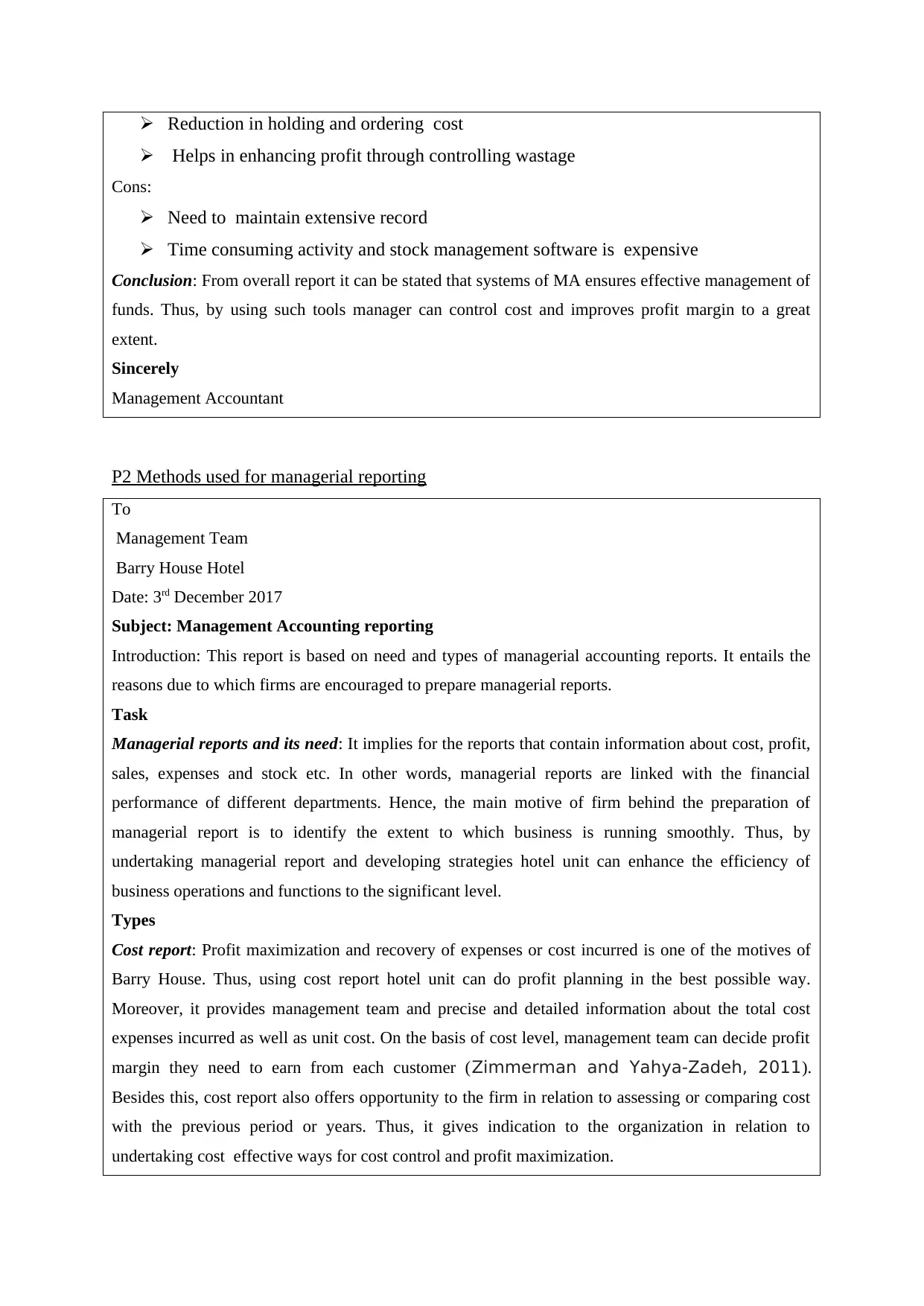
Reduction in holding and ordering cost
Helps in enhancing profit through controlling wastage
Cons:
Need to maintain extensive record
Time consuming activity and stock management software is expensive
Conclusion: From overall report it can be stated that systems of MA ensures effective management of
funds. Thus, by using such tools manager can control cost and improves profit margin to a great
extent.
Sincerely
Management Accountant
P2 Methods used for managerial reporting
To
Management Team
Barry House Hotel
Date: 3rd December 2017
Subject: Management Accounting reporting
Introduction: This report is based on need and types of managerial accounting reports. It entails the
reasons due to which firms are encouraged to prepare managerial reports.
Task
Managerial reports and its need: It implies for the reports that contain information about cost, profit,
sales, expenses and stock etc. In other words, managerial reports are linked with the financial
performance of different departments. Hence, the main motive of firm behind the preparation of
managerial report is to identify the extent to which business is running smoothly. Thus, by
undertaking managerial report and developing strategies hotel unit can enhance the efficiency of
business operations and functions to the significant level.
Types
Cost report: Profit maximization and recovery of expenses or cost incurred is one of the motives of
Barry House. Thus, using cost report hotel unit can do profit planning in the best possible way.
Moreover, it provides management team and precise and detailed information about the total cost
expenses incurred as well as unit cost. On the basis of cost level, management team can decide profit
margin they need to earn from each customer (Zimmerman and Yahya-Zadeh, 2011).
Besides this, cost report also offers opportunity to the firm in relation to assessing or comparing cost
with the previous period or years. Thus, it gives indication to the organization in relation to
undertaking cost effective ways for cost control and profit maximization.
Helps in enhancing profit through controlling wastage
Cons:
Need to maintain extensive record
Time consuming activity and stock management software is expensive
Conclusion: From overall report it can be stated that systems of MA ensures effective management of
funds. Thus, by using such tools manager can control cost and improves profit margin to a great
extent.
Sincerely
Management Accountant
P2 Methods used for managerial reporting
To
Management Team
Barry House Hotel
Date: 3rd December 2017
Subject: Management Accounting reporting
Introduction: This report is based on need and types of managerial accounting reports. It entails the
reasons due to which firms are encouraged to prepare managerial reports.
Task
Managerial reports and its need: It implies for the reports that contain information about cost, profit,
sales, expenses and stock etc. In other words, managerial reports are linked with the financial
performance of different departments. Hence, the main motive of firm behind the preparation of
managerial report is to identify the extent to which business is running smoothly. Thus, by
undertaking managerial report and developing strategies hotel unit can enhance the efficiency of
business operations and functions to the significant level.
Types
Cost report: Profit maximization and recovery of expenses or cost incurred is one of the motives of
Barry House. Thus, using cost report hotel unit can do profit planning in the best possible way.
Moreover, it provides management team and precise and detailed information about the total cost
expenses incurred as well as unit cost. On the basis of cost level, management team can decide profit
margin they need to earn from each customer (Zimmerman and Yahya-Zadeh, 2011).
Besides this, cost report also offers opportunity to the firm in relation to assessing or comparing cost
with the previous period or years. Thus, it gives indication to the organization in relation to
undertaking cost effective ways for cost control and profit maximization.
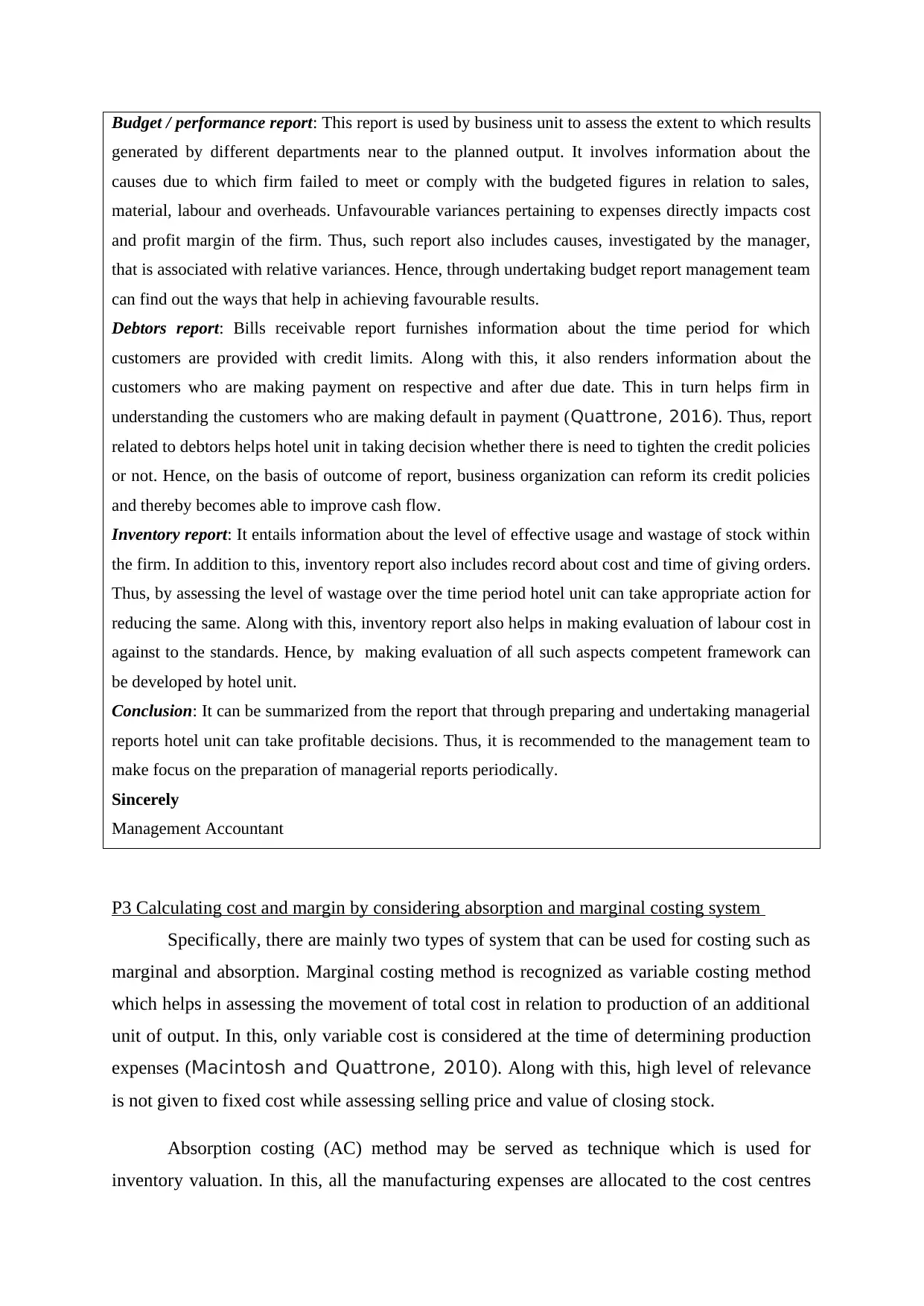
Budget / performance report: This report is used by business unit to assess the extent to which results
generated by different departments near to the planned output. It involves information about the
causes due to which firm failed to meet or comply with the budgeted figures in relation to sales,
material, labour and overheads. Unfavourable variances pertaining to expenses directly impacts cost
and profit margin of the firm. Thus, such report also includes causes, investigated by the manager,
that is associated with relative variances. Hence, through undertaking budget report management team
can find out the ways that help in achieving favourable results.
Debtors report: Bills receivable report furnishes information about the time period for which
customers are provided with credit limits. Along with this, it also renders information about the
customers who are making payment on respective and after due date. This in turn helps firm in
understanding the customers who are making default in payment (Quattrone, 2016). Thus, report
related to debtors helps hotel unit in taking decision whether there is need to tighten the credit policies
or not. Hence, on the basis of outcome of report, business organization can reform its credit policies
and thereby becomes able to improve cash flow.
Inventory report: It entails information about the level of effective usage and wastage of stock within
the firm. In addition to this, inventory report also includes record about cost and time of giving orders.
Thus, by assessing the level of wastage over the time period hotel unit can take appropriate action for
reducing the same. Along with this, inventory report also helps in making evaluation of labour cost in
against to the standards. Hence, by making evaluation of all such aspects competent framework can
be developed by hotel unit.
Conclusion: It can be summarized from the report that through preparing and undertaking managerial
reports hotel unit can take profitable decisions. Thus, it is recommended to the management team to
make focus on the preparation of managerial reports periodically.
Sincerely
Management Accountant
P3 Calculating cost and margin by considering absorption and marginal costing system
Specifically, there are mainly two types of system that can be used for costing such as
marginal and absorption. Marginal costing method is recognized as variable costing method
which helps in assessing the movement of total cost in relation to production of an additional
unit of output. In this, only variable cost is considered at the time of determining production
expenses (Macintosh and Quattrone, 2010). Along with this, high level of relevance
is not given to fixed cost while assessing selling price and value of closing stock.
Absorption costing (AC) method may be served as technique which is used for
inventory valuation. In this, all the manufacturing expenses are allocated to the cost centres
generated by different departments near to the planned output. It involves information about the
causes due to which firm failed to meet or comply with the budgeted figures in relation to sales,
material, labour and overheads. Unfavourable variances pertaining to expenses directly impacts cost
and profit margin of the firm. Thus, such report also includes causes, investigated by the manager,
that is associated with relative variances. Hence, through undertaking budget report management team
can find out the ways that help in achieving favourable results.
Debtors report: Bills receivable report furnishes information about the time period for which
customers are provided with credit limits. Along with this, it also renders information about the
customers who are making payment on respective and after due date. This in turn helps firm in
understanding the customers who are making default in payment (Quattrone, 2016). Thus, report
related to debtors helps hotel unit in taking decision whether there is need to tighten the credit policies
or not. Hence, on the basis of outcome of report, business organization can reform its credit policies
and thereby becomes able to improve cash flow.
Inventory report: It entails information about the level of effective usage and wastage of stock within
the firm. In addition to this, inventory report also includes record about cost and time of giving orders.
Thus, by assessing the level of wastage over the time period hotel unit can take appropriate action for
reducing the same. Along with this, inventory report also helps in making evaluation of labour cost in
against to the standards. Hence, by making evaluation of all such aspects competent framework can
be developed by hotel unit.
Conclusion: It can be summarized from the report that through preparing and undertaking managerial
reports hotel unit can take profitable decisions. Thus, it is recommended to the management team to
make focus on the preparation of managerial reports periodically.
Sincerely
Management Accountant
P3 Calculating cost and margin by considering absorption and marginal costing system
Specifically, there are mainly two types of system that can be used for costing such as
marginal and absorption. Marginal costing method is recognized as variable costing method
which helps in assessing the movement of total cost in relation to production of an additional
unit of output. In this, only variable cost is considered at the time of determining production
expenses (Macintosh and Quattrone, 2010). Along with this, high level of relevance
is not given to fixed cost while assessing selling price and value of closing stock.
Absorption costing (AC) method may be served as technique which is used for
inventory valuation. In this, all the manufacturing expenses are allocated to the cost centres
⊘ This is a preview!⊘
Do you want full access?
Subscribe today to unlock all pages.

Trusted by 1+ million students worldwide
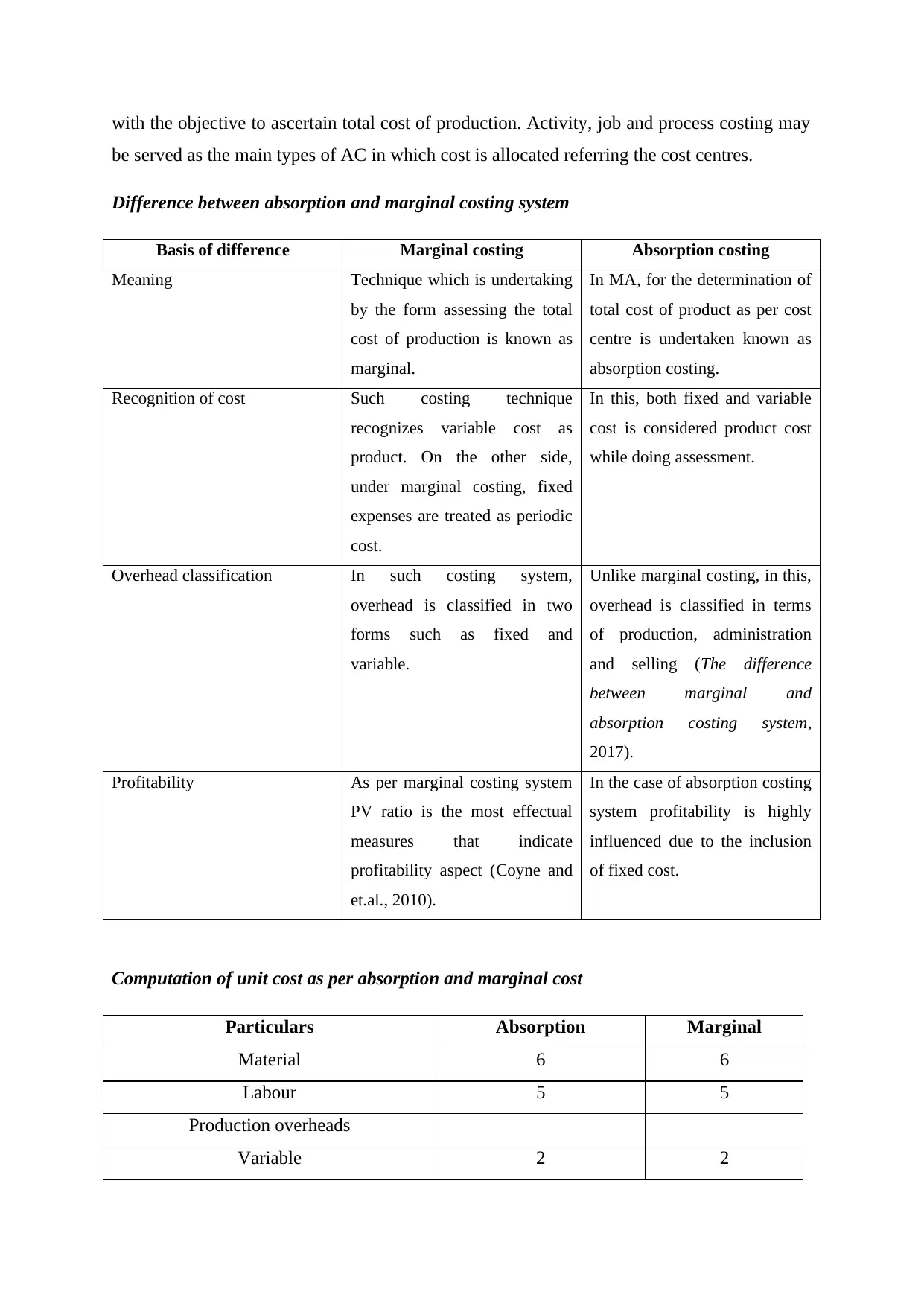
with the objective to ascertain total cost of production. Activity, job and process costing may
be served as the main types of AC in which cost is allocated referring the cost centres.
Difference between absorption and marginal costing system
Basis of difference Marginal costing Absorption costing
Meaning Technique which is undertaking
by the form assessing the total
cost of production is known as
marginal.
In MA, for the determination of
total cost of product as per cost
centre is undertaken known as
absorption costing.
Recognition of cost Such costing technique
recognizes variable cost as
product. On the other side,
under marginal costing, fixed
expenses are treated as periodic
cost.
In this, both fixed and variable
cost is considered product cost
while doing assessment.
Overhead classification In such costing system,
overhead is classified in two
forms such as fixed and
variable.
Unlike marginal costing, in this,
overhead is classified in terms
of production, administration
and selling (The difference
between marginal and
absorption costing system,
2017).
Profitability As per marginal costing system
PV ratio is the most effectual
measures that indicate
profitability aspect (Coyne and
et.al., 2010).
In the case of absorption costing
system profitability is highly
influenced due to the inclusion
of fixed cost.
Computation of unit cost as per absorption and marginal cost
Particulars Absorption Marginal
Material 6 6
Labour 5 5
Production overheads
Variable 2 2
be served as the main types of AC in which cost is allocated referring the cost centres.
Difference between absorption and marginal costing system
Basis of difference Marginal costing Absorption costing
Meaning Technique which is undertaking
by the form assessing the total
cost of production is known as
marginal.
In MA, for the determination of
total cost of product as per cost
centre is undertaken known as
absorption costing.
Recognition of cost Such costing technique
recognizes variable cost as
product. On the other side,
under marginal costing, fixed
expenses are treated as periodic
cost.
In this, both fixed and variable
cost is considered product cost
while doing assessment.
Overhead classification In such costing system,
overhead is classified in two
forms such as fixed and
variable.
Unlike marginal costing, in this,
overhead is classified in terms
of production, administration
and selling (The difference
between marginal and
absorption costing system,
2017).
Profitability As per marginal costing system
PV ratio is the most effectual
measures that indicate
profitability aspect (Coyne and
et.al., 2010).
In the case of absorption costing
system profitability is highly
influenced due to the inclusion
of fixed cost.
Computation of unit cost as per absorption and marginal cost
Particulars Absorption Marginal
Material 6 6
Labour 5 5
Production overheads
Variable 2 2
Paraphrase This Document
Need a fresh take? Get an instant paraphrase of this document with our AI Paraphraser
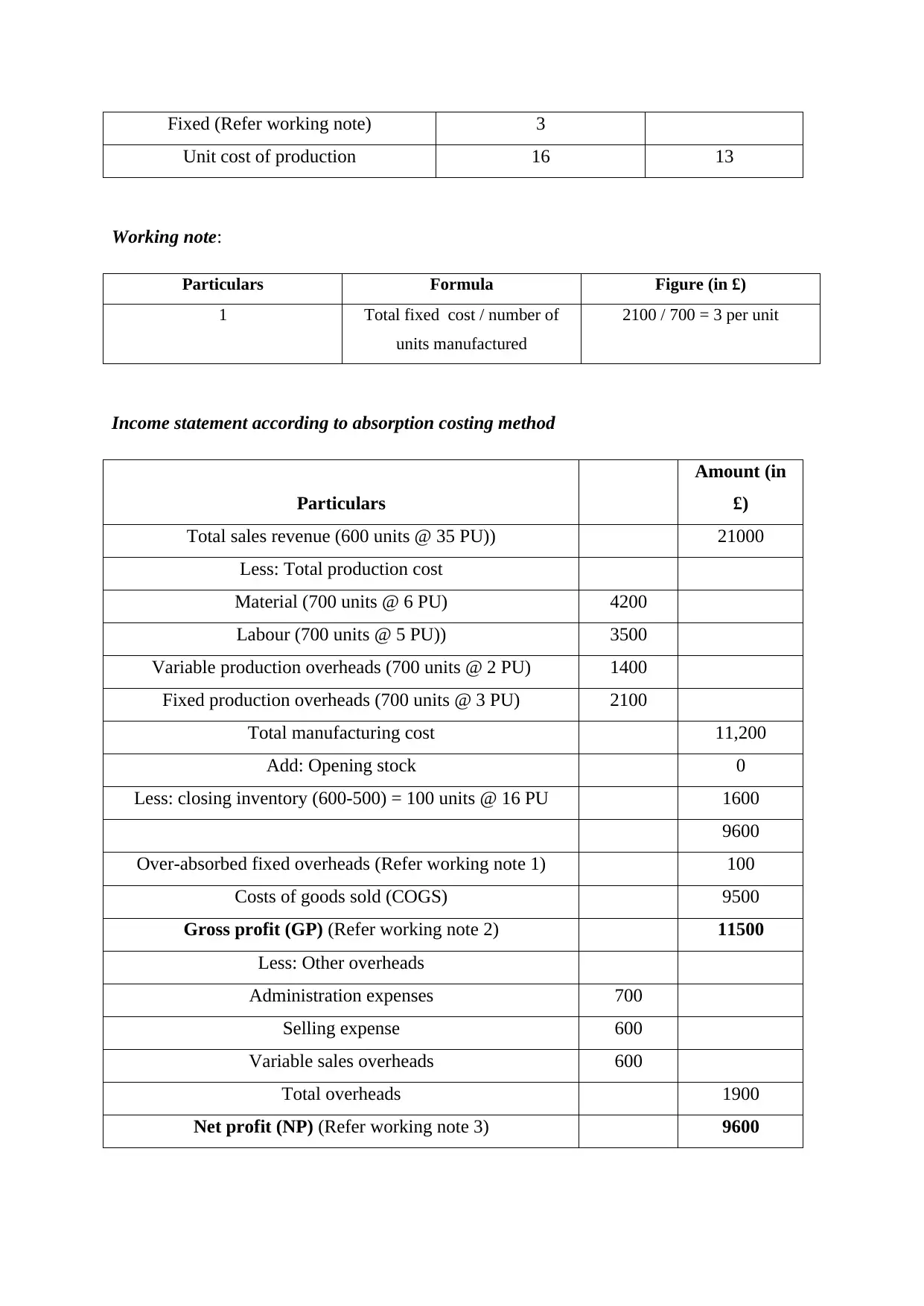
Fixed (Refer working note) 3
Unit cost of production 16 13
Working note:
Particulars Formula Figure (in £)
1 Total fixed cost / number of
units manufactured
2100 / 700 = 3 per unit
Income statement according to absorption costing method
Particulars
Amount (in
£)
Total sales revenue (600 units @ 35 PU)) 21000
Less: Total production cost
Material (700 units @ 6 PU) 4200
Labour (700 units @ 5 PU)) 3500
Variable production overheads (700 units @ 2 PU) 1400
Fixed production overheads (700 units @ 3 PU) 2100
Total manufacturing cost 11,200
Add: Opening stock 0
Less: closing inventory (600-500) = 100 units @ 16 PU 1600
9600
Over-absorbed fixed overheads (Refer working note 1) 100
Costs of goods sold (COGS) 9500
Gross profit (GP) (Refer working note 2) 11500
Less: Other overheads
Administration expenses 700
Selling expense 600
Variable sales overheads 600
Total overheads 1900
Net profit (NP) (Refer working note 3) 9600
Unit cost of production 16 13
Working note:
Particulars Formula Figure (in £)
1 Total fixed cost / number of
units manufactured
2100 / 700 = 3 per unit
Income statement according to absorption costing method
Particulars
Amount (in
£)
Total sales revenue (600 units @ 35 PU)) 21000
Less: Total production cost
Material (700 units @ 6 PU) 4200
Labour (700 units @ 5 PU)) 3500
Variable production overheads (700 units @ 2 PU) 1400
Fixed production overheads (700 units @ 3 PU) 2100
Total manufacturing cost 11,200
Add: Opening stock 0
Less: closing inventory (600-500) = 100 units @ 16 PU 1600
9600
Over-absorbed fixed overheads (Refer working note 1) 100
Costs of goods sold (COGS) 9500
Gross profit (GP) (Refer working note 2) 11500
Less: Other overheads
Administration expenses 700
Selling expense 600
Variable sales overheads 600
Total overheads 1900
Net profit (NP) (Refer working note 3) 9600
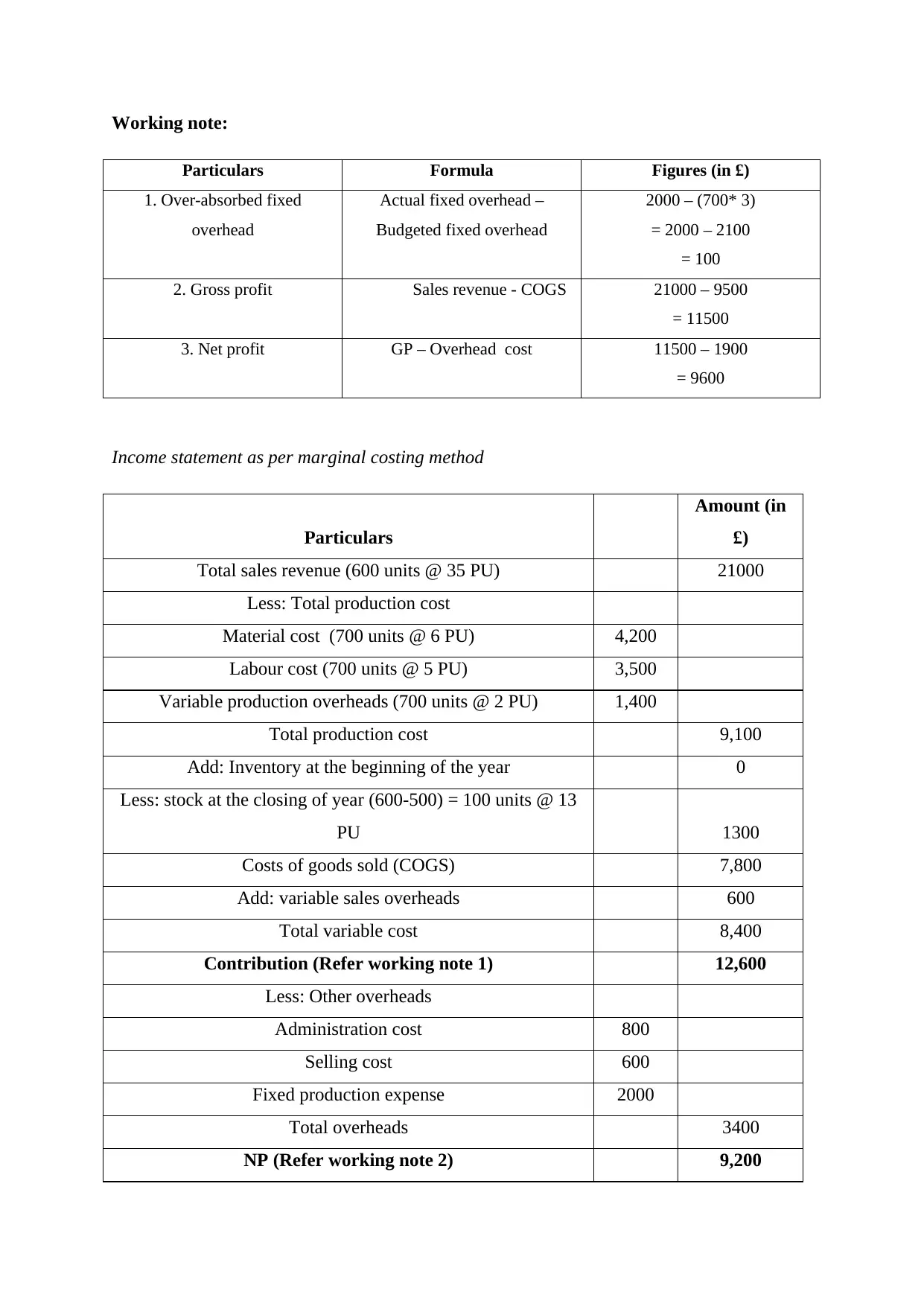
Working note:
Particulars Formula Figures (in £)
1. Over-absorbed fixed
overhead
Actual fixed overhead –
Budgeted fixed overhead
2000 – (700* 3)
= 2000 – 2100
= 100
2. Gross profit Sales revenue - COGS 21000 – 9500
= 11500
3. Net profit GP – Overhead cost 11500 – 1900
= 9600
Income statement as per marginal costing method
Particulars
Amount (in
£)
Total sales revenue (600 units @ 35 PU) 21000
Less: Total production cost
Material cost (700 units @ 6 PU) 4,200
Labour cost (700 units @ 5 PU) 3,500
Variable production overheads (700 units @ 2 PU) 1,400
Total production cost 9,100
Add: Inventory at the beginning of the year 0
Less: stock at the closing of year (600-500) = 100 units @ 13
PU 1300
Costs of goods sold (COGS) 7,800
Add: variable sales overheads 600
Total variable cost 8,400
Contribution (Refer working note 1) 12,600
Less: Other overheads
Administration cost 800
Selling cost 600
Fixed production expense 2000
Total overheads 3400
NP (Refer working note 2) 9,200
Particulars Formula Figures (in £)
1. Over-absorbed fixed
overhead
Actual fixed overhead –
Budgeted fixed overhead
2000 – (700* 3)
= 2000 – 2100
= 100
2. Gross profit Sales revenue - COGS 21000 – 9500
= 11500
3. Net profit GP – Overhead cost 11500 – 1900
= 9600
Income statement as per marginal costing method
Particulars
Amount (in
£)
Total sales revenue (600 units @ 35 PU) 21000
Less: Total production cost
Material cost (700 units @ 6 PU) 4,200
Labour cost (700 units @ 5 PU) 3,500
Variable production overheads (700 units @ 2 PU) 1,400
Total production cost 9,100
Add: Inventory at the beginning of the year 0
Less: stock at the closing of year (600-500) = 100 units @ 13
PU 1300
Costs of goods sold (COGS) 7,800
Add: variable sales overheads 600
Total variable cost 8,400
Contribution (Refer working note 1) 12,600
Less: Other overheads
Administration cost 800
Selling cost 600
Fixed production expense 2000
Total overheads 3400
NP (Refer working note 2) 9,200
⊘ This is a preview!⊘
Do you want full access?
Subscribe today to unlock all pages.

Trusted by 1+ million students worldwide
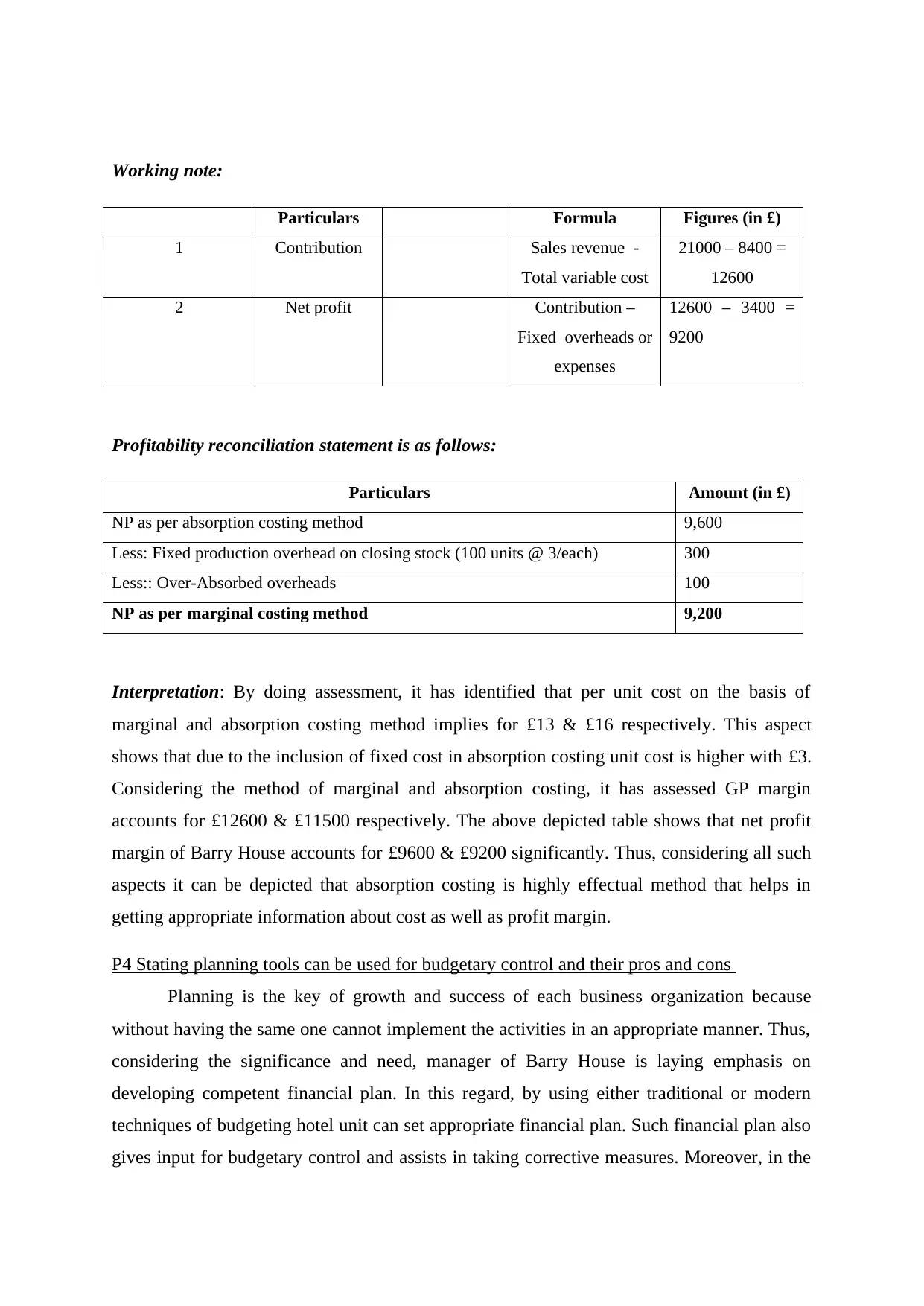
Working note:
Particulars Formula Figures (in £)
1 Contribution Sales revenue -
Total variable cost
21000 – 8400 =
12600
2 Net profit Contribution –
Fixed overheads or
expenses
12600 – 3400 =
9200
Profitability reconciliation statement is as follows:
Particulars Amount (in £)
NP as per absorption costing method 9,600
Less: Fixed production overhead on closing stock (100 units @ 3/each) 300
Less:: Over-Absorbed overheads 100
NP as per marginal costing method 9,200
Interpretation: By doing assessment, it has identified that per unit cost on the basis of
marginal and absorption costing method implies for £13 & £16 respectively. This aspect
shows that due to the inclusion of fixed cost in absorption costing unit cost is higher with £3.
Considering the method of marginal and absorption costing, it has assessed GP margin
accounts for £12600 & £11500 respectively. The above depicted table shows that net profit
margin of Barry House accounts for £9600 & £9200 significantly. Thus, considering all such
aspects it can be depicted that absorption costing is highly effectual method that helps in
getting appropriate information about cost as well as profit margin.
P4 Stating planning tools can be used for budgetary control and their pros and cons
Planning is the key of growth and success of each business organization because
without having the same one cannot implement the activities in an appropriate manner. Thus,
considering the significance and need, manager of Barry House is laying emphasis on
developing competent financial plan. In this regard, by using either traditional or modern
techniques of budgeting hotel unit can set appropriate financial plan. Such financial plan also
gives input for budgetary control and assists in taking corrective measures. Moreover, in the
Particulars Formula Figures (in £)
1 Contribution Sales revenue -
Total variable cost
21000 – 8400 =
12600
2 Net profit Contribution –
Fixed overheads or
expenses
12600 – 3400 =
9200
Profitability reconciliation statement is as follows:
Particulars Amount (in £)
NP as per absorption costing method 9,600
Less: Fixed production overhead on closing stock (100 units @ 3/each) 300
Less:: Over-Absorbed overheads 100
NP as per marginal costing method 9,200
Interpretation: By doing assessment, it has identified that per unit cost on the basis of
marginal and absorption costing method implies for £13 & £16 respectively. This aspect
shows that due to the inclusion of fixed cost in absorption costing unit cost is higher with £3.
Considering the method of marginal and absorption costing, it has assessed GP margin
accounts for £12600 & £11500 respectively. The above depicted table shows that net profit
margin of Barry House accounts for £9600 & £9200 significantly. Thus, considering all such
aspects it can be depicted that absorption costing is highly effectual method that helps in
getting appropriate information about cost as well as profit margin.
P4 Stating planning tools can be used for budgetary control and their pros and cons
Planning is the key of growth and success of each business organization because
without having the same one cannot implement the activities in an appropriate manner. Thus,
considering the significance and need, manager of Barry House is laying emphasis on
developing competent financial plan. In this regard, by using either traditional or modern
techniques of budgeting hotel unit can set appropriate financial plan. Such financial plan also
gives input for budgetary control and assists in taking corrective measures. Moreover, in the
Paraphrase This Document
Need a fresh take? Get an instant paraphrase of this document with our AI Paraphraser
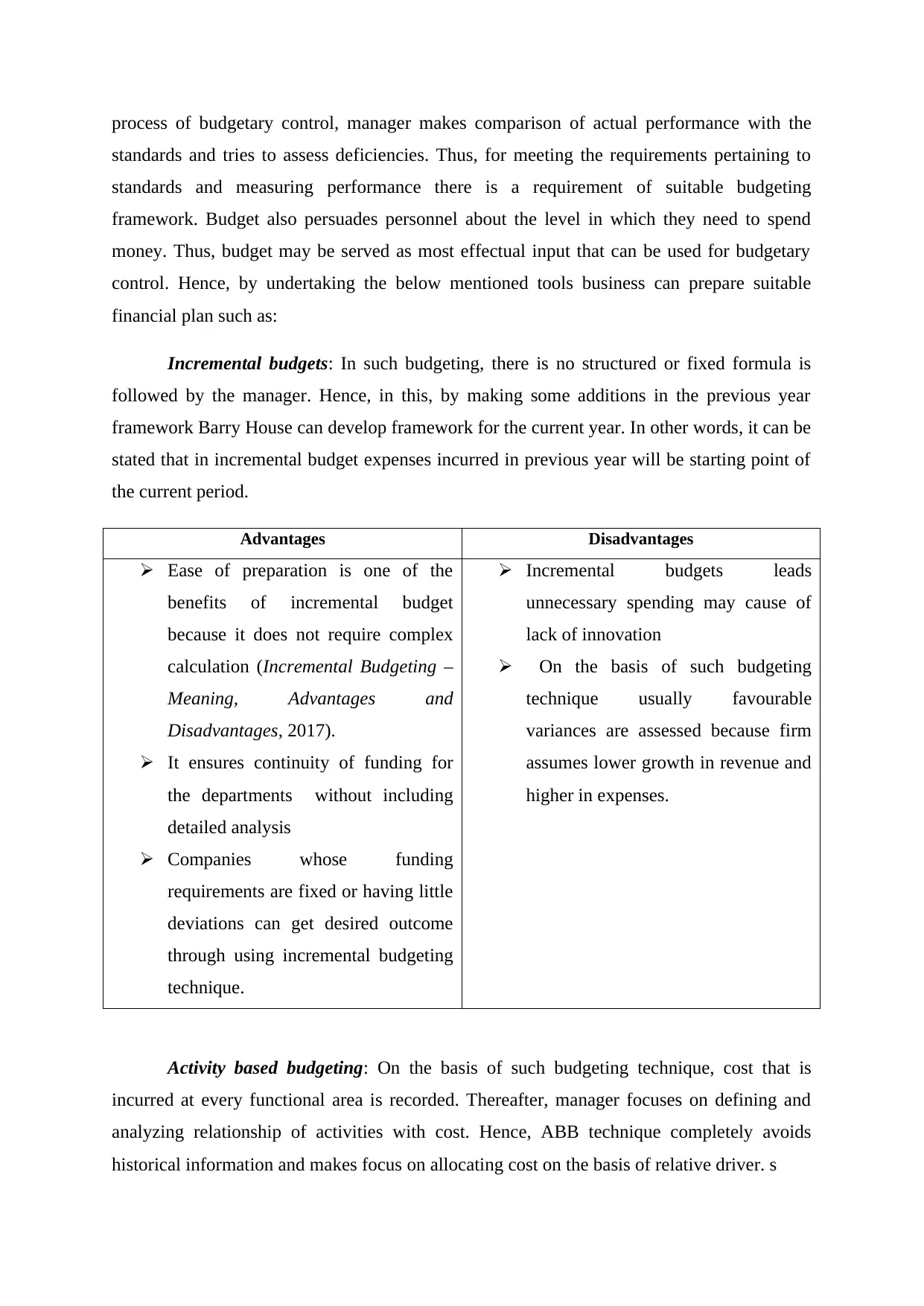
process of budgetary control, manager makes comparison of actual performance with the
standards and tries to assess deficiencies. Thus, for meeting the requirements pertaining to
standards and measuring performance there is a requirement of suitable budgeting
framework. Budget also persuades personnel about the level in which they need to spend
money. Thus, budget may be served as most effectual input that can be used for budgetary
control. Hence, by undertaking the below mentioned tools business can prepare suitable
financial plan such as:
Incremental budgets: In such budgeting, there is no structured or fixed formula is
followed by the manager. Hence, in this, by making some additions in the previous year
framework Barry House can develop framework for the current year. In other words, it can be
stated that in incremental budget expenses incurred in previous year will be starting point of
the current period.
Advantages Disadvantages
Ease of preparation is one of the
benefits of incremental budget
because it does not require complex
calculation (Incremental Budgeting –
Meaning, Advantages and
Disadvantages, 2017).
It ensures continuity of funding for
the departments without including
detailed analysis
Companies whose funding
requirements are fixed or having little
deviations can get desired outcome
through using incremental budgeting
technique.
Incremental budgets leads
unnecessary spending may cause of
lack of innovation
On the basis of such budgeting
technique usually favourable
variances are assessed because firm
assumes lower growth in revenue and
higher in expenses.
Activity based budgeting: On the basis of such budgeting technique, cost that is
incurred at every functional area is recorded. Thereafter, manager focuses on defining and
analyzing relationship of activities with cost. Hence, ABB technique completely avoids
historical information and makes focus on allocating cost on the basis of relative driver. s
standards and tries to assess deficiencies. Thus, for meeting the requirements pertaining to
standards and measuring performance there is a requirement of suitable budgeting
framework. Budget also persuades personnel about the level in which they need to spend
money. Thus, budget may be served as most effectual input that can be used for budgetary
control. Hence, by undertaking the below mentioned tools business can prepare suitable
financial plan such as:
Incremental budgets: In such budgeting, there is no structured or fixed formula is
followed by the manager. Hence, in this, by making some additions in the previous year
framework Barry House can develop framework for the current year. In other words, it can be
stated that in incremental budget expenses incurred in previous year will be starting point of
the current period.
Advantages Disadvantages
Ease of preparation is one of the
benefits of incremental budget
because it does not require complex
calculation (Incremental Budgeting –
Meaning, Advantages and
Disadvantages, 2017).
It ensures continuity of funding for
the departments without including
detailed analysis
Companies whose funding
requirements are fixed or having little
deviations can get desired outcome
through using incremental budgeting
technique.
Incremental budgets leads
unnecessary spending may cause of
lack of innovation
On the basis of such budgeting
technique usually favourable
variances are assessed because firm
assumes lower growth in revenue and
higher in expenses.
Activity based budgeting: On the basis of such budgeting technique, cost that is
incurred at every functional area is recorded. Thereafter, manager focuses on defining and
analyzing relationship of activities with cost. Hence, ABB technique completely avoids
historical information and makes focus on allocating cost on the basis of relative driver. s
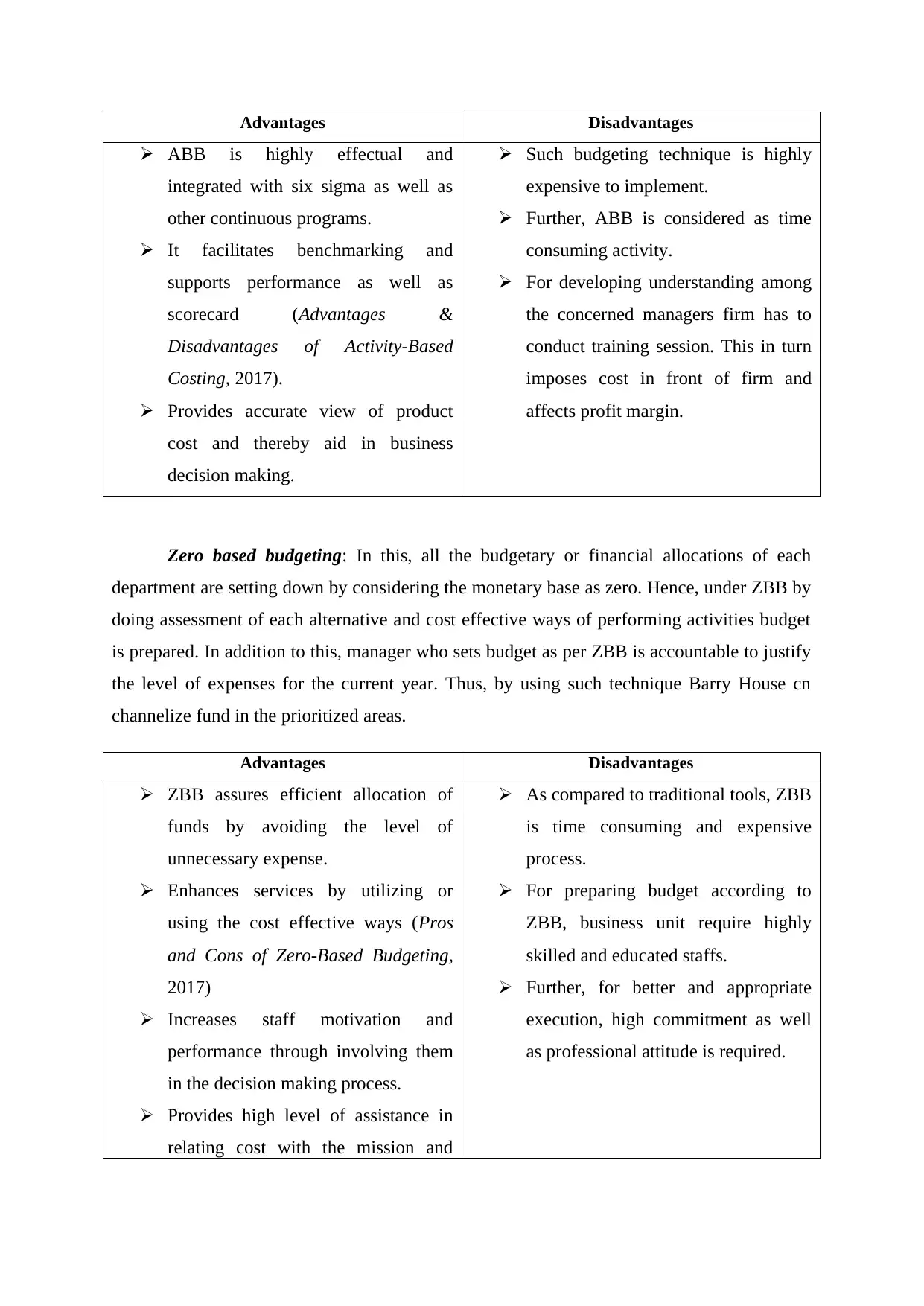
Advantages Disadvantages
ABB is highly effectual and
integrated with six sigma as well as
other continuous programs.
It facilitates benchmarking and
supports performance as well as
scorecard (Advantages &
Disadvantages of Activity-Based
Costing, 2017).
Provides accurate view of product
cost and thereby aid in business
decision making.
Such budgeting technique is highly
expensive to implement.
Further, ABB is considered as time
consuming activity.
For developing understanding among
the concerned managers firm has to
conduct training session. This in turn
imposes cost in front of firm and
affects profit margin.
Zero based budgeting: In this, all the budgetary or financial allocations of each
department are setting down by considering the monetary base as zero. Hence, under ZBB by
doing assessment of each alternative and cost effective ways of performing activities budget
is prepared. In addition to this, manager who sets budget as per ZBB is accountable to justify
the level of expenses for the current year. Thus, by using such technique Barry House cn
channelize fund in the prioritized areas.
Advantages Disadvantages
ZBB assures efficient allocation of
funds by avoiding the level of
unnecessary expense.
Enhances services by utilizing or
using the cost effective ways (Pros
and Cons of Zero-Based Budgeting,
2017)
Increases staff motivation and
performance through involving them
in the decision making process.
Provides high level of assistance in
relating cost with the mission and
As compared to traditional tools, ZBB
is time consuming and expensive
process.
For preparing budget according to
ZBB, business unit require highly
skilled and educated staffs.
Further, for better and appropriate
execution, high commitment as well
as professional attitude is required.
ABB is highly effectual and
integrated with six sigma as well as
other continuous programs.
It facilitates benchmarking and
supports performance as well as
scorecard (Advantages &
Disadvantages of Activity-Based
Costing, 2017).
Provides accurate view of product
cost and thereby aid in business
decision making.
Such budgeting technique is highly
expensive to implement.
Further, ABB is considered as time
consuming activity.
For developing understanding among
the concerned managers firm has to
conduct training session. This in turn
imposes cost in front of firm and
affects profit margin.
Zero based budgeting: In this, all the budgetary or financial allocations of each
department are setting down by considering the monetary base as zero. Hence, under ZBB by
doing assessment of each alternative and cost effective ways of performing activities budget
is prepared. In addition to this, manager who sets budget as per ZBB is accountable to justify
the level of expenses for the current year. Thus, by using such technique Barry House cn
channelize fund in the prioritized areas.
Advantages Disadvantages
ZBB assures efficient allocation of
funds by avoiding the level of
unnecessary expense.
Enhances services by utilizing or
using the cost effective ways (Pros
and Cons of Zero-Based Budgeting,
2017)
Increases staff motivation and
performance through involving them
in the decision making process.
Provides high level of assistance in
relating cost with the mission and
As compared to traditional tools, ZBB
is time consuming and expensive
process.
For preparing budget according to
ZBB, business unit require highly
skilled and educated staffs.
Further, for better and appropriate
execution, high commitment as well
as professional attitude is required.
⊘ This is a preview!⊘
Do you want full access?
Subscribe today to unlock all pages.

Trusted by 1+ million students worldwide
1 out of 15
Related Documents
Your All-in-One AI-Powered Toolkit for Academic Success.
+13062052269
info@desklib.com
Available 24*7 on WhatsApp / Email
![[object Object]](/_next/static/media/star-bottom.7253800d.svg)
Unlock your academic potential
Copyright © 2020–2025 A2Z Services. All Rights Reserved. Developed and managed by ZUCOL.





